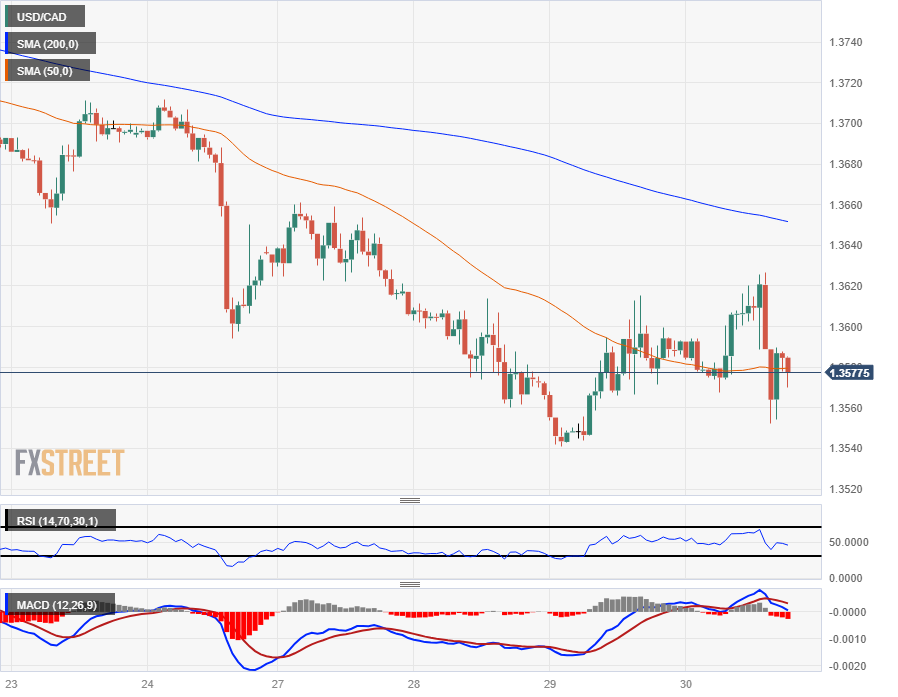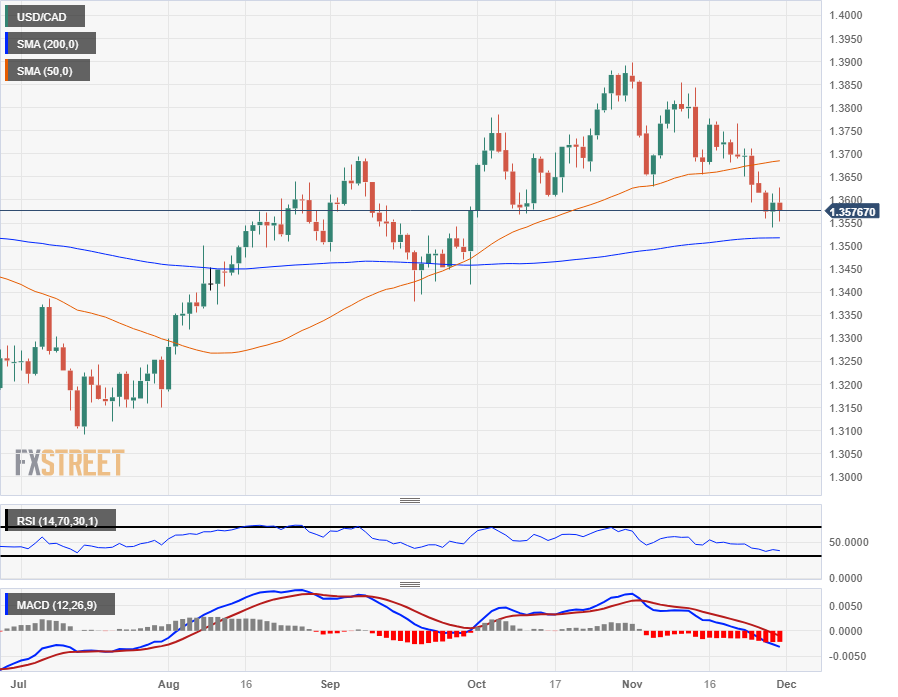- The Canadian dollar is experiencing a general rise in the markets.
- Canadian GDP is mixed, but underlying revisions are helping to bolster the CAD.
- OPEC supply cuts to prop up crude oil markets underpin CAD trading.
He Canadian dollar (CAD) is receiving a batch of bids during the Thursday session in the US, bolstered by the rally in Crude Oil. The Canadian Dollar is the best performing currency within the major currency bloc, in the green against all major currencies, while the Loonie heads to the end of the trading day on Thursday.
Canadian Gross Domestic Product (GDP) was mixed, but positive in the short term, and Crude Oil is lending some support to the Loonie. The Organization of the Petroleum Exporting Countries (OPEC) unanimously agreed to additional production cuts with an ambiguous end date.
Daily Market Movement Summary: Canadian Dollar Makes Late Breakout Towards the Rise
- The Canadian dollar posted a late rally on Thursday and outperformed the rest of the major currency bloc.
- At the time of writing, the CAD is up almost one percentage point against the Japanese Yen (JPY) and the Euro (EUR), and around seven tenths against the British Pound (GBP).
- Canadian GDP was mixed, at 0.1% month-on-month in September, above the 0.0% forecast, while the year-on-year figure suffered a sharp contraction.
- Annualized Canadian GDP for the third quarter stood at -1.1%, well below the average market forecast of 0.2% year-on-year growth, but the figure for the previous period was sharply revised upwards, going from -0.2% to 1.4%.
- Crude oil markets are preparing for an upward turn after OPEC unanimously agreed (for the moment) to further cut oil production by one million barrels per day (bpd).
- Crude Oil price increases from additional supply cuts are likely to remain limited by abundant excess capacity in global energy demand.
- OPEC reports that additional production limits will remain in place until the first quarter of 2024.
- Despite the overall strength of the CAD, the Loonie is only up 0.05% against the US dollar.
- The Canadian unemployment rate will be released on Friday and is expected to rise slightly from 5.7% to 5.8% in November.
Current rate of the Canadian dollar
Below is the percentage change of the Canadian Dollar (CAD) against the currencies listed today. The Canadian dollar appreciated against the Japanese yen.
| USD | EUR | GBP | CAD | AUD | JPY | NZD | CHF | |
| USD | 0.78% | 0.61% | -0.10% | 0.21% | 0.81% | 0.07% | 0.31% | |
| EUR | -0.78% | -0.18% | -0.88% | -0.56% | 0.04% | -0.72% | -0.49% | |
| GBP | -0.61% | 0.19% | -0.70% | -0.39% | 0.23% | -0.53% | -0.30% | |
| CAD | 0.11% | 0.89% | 0.71% | 0.32% | 0.92% | 0.17% | 0.41% | |
| AUD | -0.24% | 0.58% | 0.38% | -0.31% | 0.61% | -0.15% | 0.07% | |
| JPY | -0.82% | -0.05% | -0.24% | -0.93% | -0.62% | -0.77% | -0.52% | |
| NZD | -0.07% | 0.72% | 0.53% | -0.17% | 0.15% | 0.74% | 0.24% | |
| CHF | -0.28% | 0.50% | 0.31% | -0.40% | -0.08% | 0.52% | -0.23% |
The map shows the percentage changes of the major currencies against each other. The base currency is chosen in the left column, while the quote currency is chosen in the top row. For example, if you choose the euro in the left column and scroll down the horizontal line to the Japanese yen, the percentage change in the box will represent EUR (base)/JPY (quote).
Technical Analysis: Canadian Dollar lurches higher and USD/CAD returns below 1.3600
The Canadian Dollar (CAD) initially retreated against the US Dollar (USD) in trading on Thursday, with the pair hitting a three-day high at 1.3626, but the late breakout of the CAD saw the pair return below the 1.3600 to test the waters near 1.3550.
On the intraday chart, the stock remains capped by the 200-hour SMA moving down to 1.3650, while the 50-day SMA is pulling prices towards the short-term midrange around 1.3580.
The daily candles show the USD/CAD pair struggling to advance lower towards the 200-day SMA just above 1.3500, and the CAD is struggling to carve out more bearish territory against the USD despite the CAD’s push on Thursday.
USD/CAD Hourly Chart

USD/CAD Daily Chart

Frequently Asked Questions about the Canadian Dollar
What factors determine the price of the Canadian dollar?
The key factors that determine the price of the Canadian dollar (CAD) are the level of interest rates set by the Bank of Canada (BoC), the price of oil, Canada’s main export product, the health of its economy, inflation and the trade balance, which is the difference between the value of Canadian exports and its imports. Other factors are market confidence, that is, whether investors bet on riskier assets (risk-on) or look for safe assets (risk-off), with the risk-on being positive for the CAD. As its largest trading partner, the health of the US economy is also a key factor influencing the Canadian dollar.
How do Bank of Canada decisions affect the Canadian dollar?
The Bank of Canada (BoC) exerts significant influence over the Canadian Dollar by setting the level of interest rates that banks can lend to each other. This influences the level of interest rates for everyone. The BoC’s main objective is to keep inflation between 1% and 3% by adjusting interest rates up or down. Relatively high interest rates are usually positive for the CAD. The Bank of Canada can also use quantitative easing and tightening to influence credit conditions, with the former being negative for the CAD and the latter being positive for the CAD.
How does the price of oil affect the Canadian dollar?
The price of oil is a key factor influencing the value of the Canadian Dollar. Oil is Canada’s largest export, so the price of oil tends to have an immediate impact on the value of the CAD. Generally, if the price of oil rises, the CAD also rises, as aggregate demand for the currency increases. The opposite occurs if the price of oil falls. Higher oil prices also tend to lead to a higher probability of a positive trade balance, which also supports the CAD.
How does inflation data influence the value of the Canadian Dollar?
Although inflation has traditionally always been considered a negative factor for a currency, as it reduces the value of money, the opposite has actually happened in modern times, with the relaxation of cross-border capital controls. Higher inflation often leads central banks to raise interest rates, attracting more capital inflows from global investors looking for a lucrative place to store their money. This increases the demand for the local currency, which in the case of Canada is the Canadian Dollar.
How does economic data influence the value of the Canadian dollar?
The published macroeconomic data measures the health of the economy and may have an impact on the Canadian dollar. Indicators such as GDP, manufacturing and services PMIs, employment and consumer confidence surveys can influence the direction of the CAD. A strong economy is good for the Canadian dollar. Not only does it attract more foreign investment, but it may encourage the Bank of Canada to raise interest rates, resulting in a stronger currency. However, if economic data is weak, the CAD is likely to fall.
Source: Fx Street
I am Joshua Winder, a senior-level journalist and editor at World Stock Market. I specialize in covering news related to the stock market and economic trends. With more than 8 years of experience in this field, I have become an expert in financial reporting.



.jpg)



